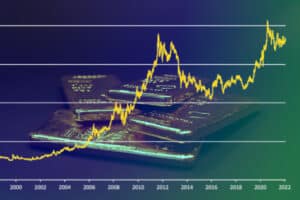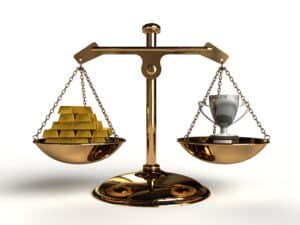As a result of the global pandemic and other global pressures, economies worldwide have been reeling, and governments have taken unprecedented fiscal measures to mitigate the impact. A good example of this is the massive stimulus packages put in place by the U.S. government to boost the economy. While these fiscal policy decisions not only affect economic indicators, they also impact the investment world and sectors such as precious metals.
If you’re concerned about the state of the economy and are looking for a way to secure your financial future, keep reading to understand how the government’s policies can impact your investments.
Understanding Fiscal Policies
Fiscal policy is the government’s strategy for managing public revenues and expenditures. The main objectives are to promote economic growth, stabilize prices, and reduce unemployment. The government ensures this by adjusting tax rates and spending levels to monitor and influence a country’s economy.
Expansionary And Contractionary Fiscal Policies
There are two types of fiscal policies: expansionary and contractionary. Expansionary policy aims to stimulate economic growth and is implemented by cutting taxes or increasing government spending.
When taxes are reduced, people and businesses are encouraged to spend more money, boosting consumption and investments. Similarly, when the government increases spending, it creates more job opportunities and enables businesses to expand their operations.
On the other hand, contractionary policy is used when the economy is growing too fast, leading to inflation. When the economy is growing too fast, there’s a lot of demand for goods and services, which can cause prices to rise.
To counter this, the government implements measures that slow economic growth, such as tax increases or spending cuts. When taxes are increased, people have less money to spend, reducing demand and slowing economic growth.
The Role Of Fiscal Policy In The U.S. Economy
The government uses fiscal policy in the United States to influence and control the overall economy. It manages business cycles, promotes economic growth, and maintains stability.
Key decisions often revolve around strategic adjustments in government spending and revenues. This is usually done through changes in tax policy or shifts within public spending programs, all aimed at either boosting or containing economic activity.
Fiscal policies affect various aspects of the economy, such as personal spending patterns, capital investment, exchange rates, deficit levels, and interest rates. In times of financial uncertainty or crisis, such as when there’s talk of an impending “fiscal cliff,” these measures become even more important.
How Fiscal Policies Can Influence Precious Metal Investments
Fiscal policies can significantly shape the landscape for precious metal investments. By understanding these impacts, investors can better navigate the market and make informed investment decisions.
Inflation And Precious Metals
Fiscal policy profoundly influences precious metals, primarily through its impact on inflation. When a government pursues an expansionary fiscal policy, there’s usually an increase in the money supply. This increase can trigger inflation, which erodes the purchasing power of the country’s currency.
In response to this scenario, investors often look for assets that maintain their value amid inflationary pressures. Historically, precious metals, particularly gold, have served this role, acting as a reliable hedge against inflation.
Even in times of economic uncertainty, gold’s consistent value increases its appeal to investors. This safe-haven status means that gold retains its value and can also provide a shield for investments when other assets lose their value.
Economic Stimulation
One of the possible consequences of fiscal policies is an increase in industrial demand for certain precious metals. These policies are often designed to support industries that are key drivers of economic growth, such as technology, renewable energy, and automotive manufacturing. These industries rely on various materials, including precious metals such as silver and platinum, for various applications, from electronic components to catalytic converters.
When the government invests in these industries through its tax policies, demand for these metals can increase, driving up their prices. This can be beneficial to companies that produce these metals, as they can earn higher revenues and profits. However, it can also lead to higher costs for other industries that rely on these metals, such as jewelry manufacturers or medical device makers.
Fiscal Deficits
When a government’s expenditures exceed its tax revenues, it must borrow to make up the shortfall. This rampant borrowing can raise concerns about the government’s ability to repay its debts, increasing economic uncertainty.
Such uncertainties can trigger fears among investors, leading them to question the government’s ability to meet its financial obligations. This fear can escalate into a potential financial crisis. During such times, investors often seek refuge in precious metals such as gold, considered safe havens.
Precious metals are highly liquid assets that can be easily bought or sold without significantly changing prices. In uncertain times, demand for precious metals increases, increasing prices. As more investors turn to these assets for financial security, the market becomes increasingly competitive, increasing prices.
Gold, in particular, can see significant price increases in economic instability due to its widely recognized status as a reliable store of value. This enduring appeal of gold and other precious metals ensures they retain their value even during economic turmoil.
Navigating Fiscal Policies As A Precious Metal Investor
Investing in precious metals is about more than just understanding the metals themselves. Understanding the broader economic environment in which these investments operate is important.
Strategies For Monitoring And Responding To Fiscal Policy Changes
Investors can use various strategies to monitor and respond to changes in financial policy effectively. Some of these include:
- Regularly follow current news, economic reports, and government announcements to stay informed of potential policy changes that could impact precious metals investments.
- Understand the objectives behind fiscal policy and how they align with broader economic goals. This analysis can help you predict the potential impact on precious metals markets.
- Track government spending patterns, especially in precious metals-related sectors such as infrastructure development, defense, or technology.
- Watch for tax rate changes and their impact on businesses and individuals. Higher tax rates, especially capital gains or corporate profits, can affect investment decisions and precious metals prices.
- Watch for fiscal stimulus measures such as increased government spending or tax incentives to spur economic growth.
- Investigate any changes in trade policies, such as tariffs or import/export restrictions. These policies can affect supply chains and global demand for precious metals.
- Pay attention to currency fluctuations resulting from fiscal policy decisions. A weaker currency can increase demand for precious metals as a safe-haven investment.
- Maintain a diversified portfolio that includes different types of precious metals (e.g., gold, silver, platinum) and other assets to mitigate the risk associated with certain fiscal policy changes.
Managing Risks Associated With Fiscal Policy Fluctuations
While fiscal policy fluctuations can pose risks to precious metals investors, certain strategies can effectively manage these risks. Some ways to manage fiscal policy fluctuation risks include:
- Pay attention to key economic indicators, such as inflation, interest, and GDP growth. These indicators can provide insight into how fiscal policy is affecting the economy and, in turn, precious metals prices.
- Seek advice from experienced financial advisors who specialize in precious metals investing. They can help you analyze market trends, navigate fiscal policy changes, and recommend appropriate investment strategies based on your individual goals and risk tolerance.
- Stay abreast of news and developments related to fiscal policy and its potential impact on precious metals markets. This can help you make informed decisions about buying or selling precious metals.
- Watch for geopolitical events that could potentially impact precious metals markets. Political instability, trade conflicts, or global tensions can increase demand for safe-haven assets like gold.
- Realize that while precious metals have always served as a store of value in uncertain times, there is no guarantee that they will always rise in price. Be prepared for fluctuations and set realistic expectations for the return on your investments.
Future Trends And Predictions
Higher interest rates are expected to impact precious metals investments significantly. When interest rates rise, fixed-income investments such as bonds become more attractive to investors since they offer higher yields.
This may lead to declining demand for precious metals such as gold, causing their prices to fall. If the Federal Reserve decides to aggressively tighten monetary policy in response to the state of the economy, this could further impact the price of precious metals. Investors need to monitor these trends closely and adjust their investment strategies accordingly.
Major banks and financial institutions have also issued forecasts for 2023 based on factors such as recession risk, inflation expectations, credit defaults, and changes in the dollar exchange rate. These projections can provide valuable insights to investors looking to address changing market dynamics and identify promising long-term investment opportunities.
Investors need to be aware of these forecasts and adjust their strategies accordingly to maximize returns and effectively manage risk. By understanding how future trends in financial policy may affect precious metals investments, investors can strategically position themselves and make informed decisions based on market conditions.
Invest In Precious Metals Today
Precious metals not only provide a hedge against inflation and currency fluctuations, but they’re also an excellent way to diversify your portfolio. Now is the time to take the first step toward securing your financial future.
Whether you prefer to call and speak with one of our representatives or click here to sign up online, the path to precious metal investment is at your fingertips. Don’t let market uncertainties dictate your financial future. Take control with help from Noble Gold Investments today.







